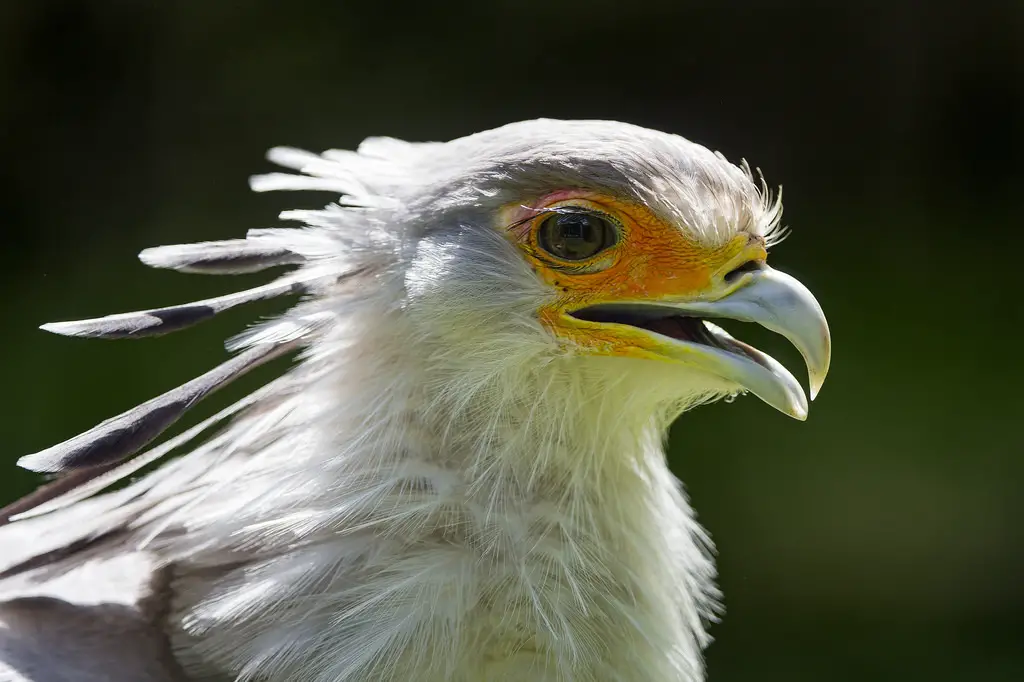The secretary bird (Sagittarius serpentarius) is an African bird of prey that is typically found in the savannah and grasslands of sub-Saharan region. It belongs to the family Sagittariidae. Apart from many characteristic features the bird shows the prominent black feathers that come out from behind its head. It is the only bird of prey that chases its prey on the ground.
Secretary Bird Facts
Anatomy
- The secretary bird is distinguished by its large eagle-like body and unique display of feathers. Unlike any other bird of prey, the secretary bird has got long legs like that of a crane.
- The hooked bill reminds us of us of an eagle. The bird has rounded wings.
- The slaty-grey appearance and the black feathers that form the crest add much to the beauty of secretary birds. They have a lighter abdomen.
- Adult birds stand 90 to 137 cm (35 to 54 in) tall. The overall length averages 112 to 152 cm (44 to 60 in) with the wingspan measuring up to 191–220 cm (75–87 in).
- The average weight of secretary birds is about 2.3 to 5 kg (5.1 to 11.0 lb).
- The secretary bird’s tail adds 57–85 cm (22–33 in) to the length.
- It is more likely to appear a crane rather than a bird of prey.
- The feathers used in the bird’s flight are all black and so as its thighs.
- Unlike any other bird of prey male secretary birds are heavier than females.

Range & Habitat
- Secretary birds are non-migratory birds and they are found in Somalia, Cape of Good Hope, Gambia, Burkina Faso, Ethiopia, Tanzania, Cameroon, Ghana, Nigeria, Uganda, South Sudan, Malawi, and Mauritania.
- It is thought to make homes in a wide variety of highlands and coastal plains. Generally the secretary bird prefers savannahs and open grasslands but avoids thick shrubbery forests and mountainous areas of western central Africa.
Feeding Ecology & Diet
- The secretary bird is terrestrial and it is likely to eat insects and small mammals including hares, mice, hares, and mongoose. Secretary bird’s diet also consists of lizards, crabs, tortoises, bird eggs, snakes, and young birds.
- It also feeds on carcasses in bush fires and grass. Secretary birds rarely go after large mammals including young gazelles.
- They will often find their prey into the tall vegetation. Secretary birds usually swallow small birds but they often give a strong chase to the prey.
Behavior
- They strike snakes with their bill while jumping on their back. Secretary birds also prey arthropods. They take bold and jaunty strides on the ground.
- Secretary birds are likely to walk 18 miles a day to find food. During the broad daylight, they remain in the shade of a tree.
- They will spend much of their daytime on the ground while at night birds roost on the acacia trees.
- The walking speed of the secretary bird is 3 miles per hour. It may not tolerate any outsider bird walking in its territory and to ensure this the bird often takes to the sky.

Reproductive Biology
- The breeding occurs all year round but they mostly mate in spring and summer.
- Secretary birds pair for life. The mating occurs on the ground but sometimes they mate into the acacia trees.
- The pair builds a strong bond between them which they maintain even after the chicks are flown away.
- They build nests 5–7 m (16–23 ft) high on Acacia trees.
- Both parents continue to visit the nesting sites for nearly 6 months.
- The width of the nest is about 2.5 m (eight feet) and the depth measuring up to 30 cm (1 foot).
- The breeding interval is one year.
- The female lays 2 – 3 pale green eggs which she alone incubates.
- The incubation period lasts 45 days.
- Both parents feed the chicks. Young fledges out in about 65 – 80 days though they learn to flap their wings earlier than that.
- The are thought to build nests on a thorny tree.
- Both parents reach maturity at 2 years age.
- The typical lifespan of a secretary bird is about 10 – 12 years.
- Predators of secretary birds include hornbills, kites, crows, ravens, and large owls.
Conservation Status
Vulnerable






Leave a Reply